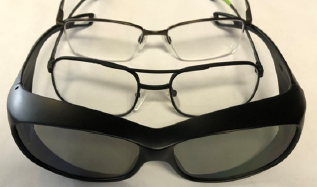
Vergence-accommodation (VA) mismatch is a component of stereoscopic 3D remote vision system (RVS) design linked to depth misperception and visual discomfort. VA mismatch is caused by an unnatural conflict between the focal distance of the image (and thus accommodative demand) and the binocular vergence demand. A possible solution to mitigate VA mismatch is to change the accommodative demand with an optical correction, reducing the mismatch with the vergence demand. This experiment investigated the effect of low-add spectacle lenses (eyewear) on RVS performance and visual comfort. While previous research showed a positive effect of decreasing VA mismatch with the use of switchable lenses to adjust focal distance, the optical changes in this investigation were insufficient to make a difference. We conclude that the use of eyewear with a small dioptric add is not an effective solution to improve stereoscopic RVS performance or viewing comfort.

Three-dimensional (3D) displays become more and more popular in many fields. However, visual fatigue is one of the critical factors that impede the wide range of applications of 3D technology. Although many studies have investigated the 3D visual fatigue, a few of them are based on continuous viewing 3D contents. In this paper, we propose a method to evaluate visual fatigue through subjective scoring and objective measuring the physiological parameters during the continuous viewing 3D/2D movie. In the viewing, we test the objective and subjective indicators, including the heart rate (HR), blink frequency (BF) and percentage of eyelid closure over the pupil over time (PERCLOS) and the subjective scoring (SS). Before and after viewing the video, VRT, PMA and questionnaires are measured. Experimental results showed that the subjective score and objective indicates of visual fatigue increased gradually with viewing time although it was fluctuated. The symptoms of visual fatigue were generally more serious after viewing 3D movie than 2D ones. Based on the results above, a model was built to predict visual fatigue from HR and BF during continuous viewing 3D video processes.